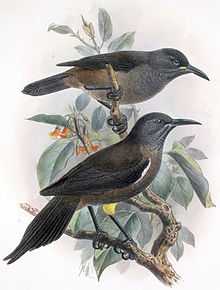Kauaʻi ʻōʻō
| Kauaʻi ʻōʻō | |
|---|---|
 | |
| Conservation status | |
| Scientific classification | |
| Kingdom: | Animalia |
| Phylum: | Chordata |
| Class: | Aves |
| Order: | Passeriformes |
| Family: | † Mohoidae |
| Genus: | † Moho |
| Species: | † M. braccatus |
| Binomial name | |
| Moho braccatus (Cassin, 1855) | |
The Kauaʻi ʻōʻō or ʻōʻōʻāʻā (Moho braccatus) is a member of the extinct genus of the ʻōʻōs (Moho) within the extinct family Mohoidae from the islands of Hawai'i. It was previously regarded as member of the Australo-Pacific honeyeaters (Meliphagidae).[2] This bird was endemic to the island of Kauaʻi. It was common in the subtropical forests of the island until the early twentieth century, when its decline began. Its song was last heard in 1987 and it has since been declared extinct. The causes of its extinction include the introduction of the Polynesian rat, domestic pig, and mosquitoes carrying avian disease (avian malaria and avian pox), as well as habitat destruction.

This bird was among the smallest of the Hawaiian honeyeaters, if not the smallest species, at just over 20 centimetres (7.9 in) in length. It was black or very dark shiny brown with sparse yellow leg feathers and faint white banding on the breast and underwings. It was the only ‘ō’ō known to have eyes with yellowish irises. It was named the ʻōʻō ʻāʻā by the natives which means dwarf ʻōʻō. Like other honeyeaters it had a sharp, slightly curved bill for sampling nectar. Its favored nectar sources were Lobelia species and the ʻohiʻa lehua tree, and it also ate small invertebrates and fruit.
The bird was a cavity nester in the thickly forested canyons of Kauaʻi. Many of its relatives have also become extinct, such as the Hawaiʻi ʻōʻō, Bishop's ʻōʻō, and Oʻahu ʻōʻō. Little is known about these extinct birds. The species may have become extinct from a large range of problems, including mosquito-transmitted diseases, which caused the species to retreat to higher ground. Higher elevation forests lack tree cavities, so few, if any, nests could be made. The final blow was two hurricanes coming within ten years of each other. They destroyed many of the old trees with cavities, and prohibited tree growth when the second one arrived, causing the species to disappear. The bird was last sighted in 1985, and a sound recording was made in 1987 by David Boynton.[3] It is conceivable that the species may survive undetected as the species had been proclaimed extinct twice: once in the 1940s (later rediscovered in 1950) and again from the late 1950s to the early 1970s, being rediscovered by S. R. Sabo. However, it has a loud and distinctive call, and intensive surveys have failed to find any since 1987.
In culture: The album O'o by jazz composer John Zorn released in 2009 is named after the bird, and its artwork includes its likeness.
References
- ↑ BirdLife International (2012). "Moho braccatus". IUCN Red List of Threatened Species. Version 2013.2. International Union for Conservation of Nature. Retrieved 26 November 2013.
- ↑ Fleischer R.C., James H.F., and Olson S.L. (2008). Convergent Evolution of Hawaiian and Australo-Pacific Honeyeaters from Distant Songbird Ancestors. Current Biology, Volume 18, Issue 24, 1927-1931, 11 December 2008.
- ↑ "Kauai Oo Moho braccatus". Birdlife International. Retrieved 24 January 2010.
External links
- Kauaʻi ʻōʻō - only footage known to exist
- 3D view of specimens RMNH 110.028 and RMNH 110.029 at Naturalis, Leiden (requires QuickTime browser plugin).
- "Kauaʻi ʻŌʻō" (PDF). Hawaii’s Comprehensive Wildlife Conservation Strategy. State of Hawaiʻi. 2005-10-01.
